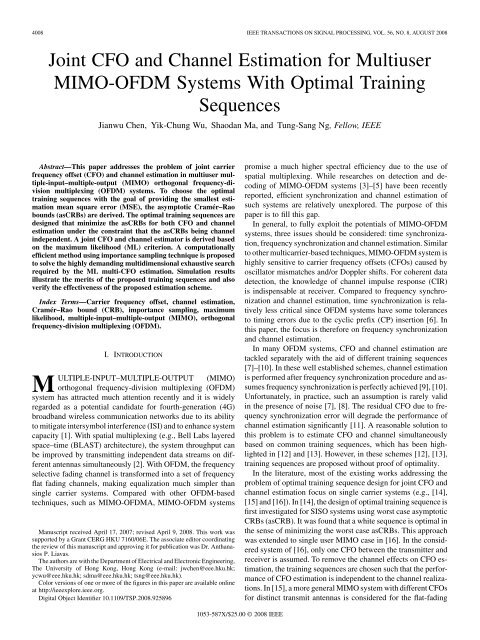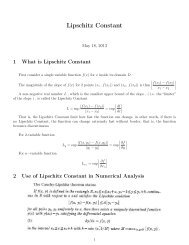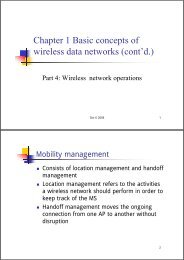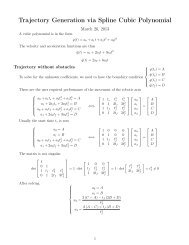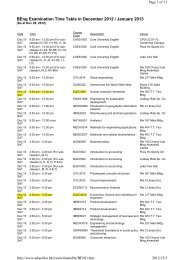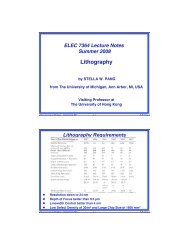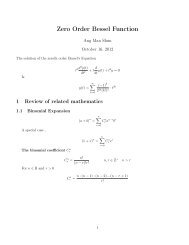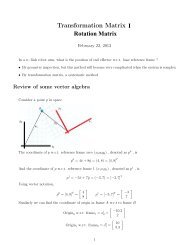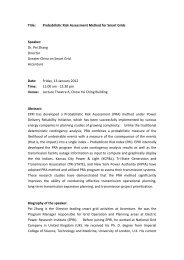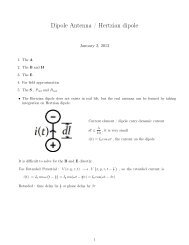Joint CFO and Channel Estimation for Multiuser MIMO-OFDM ...
Joint CFO and Channel Estimation for Multiuser MIMO-OFDM ...
Joint CFO and Channel Estimation for Multiuser MIMO-OFDM ...
You also want an ePaper? Increase the reach of your titles
YUMPU automatically turns print PDFs into web optimized ePapers that Google loves.
4008 IEEE TRANSACTIONS ON SIGNAL PROCESSING, VOL. 56, NO. 8, AUGUST 2008<br />
<strong>Joint</strong> <strong>CFO</strong> <strong>and</strong> <strong>Channel</strong> <strong>Estimation</strong> <strong>for</strong> <strong>Multiuser</strong><br />
<strong>MIMO</strong>-<strong>OFDM</strong> Systems With Optimal Training<br />
Sequences<br />
Jianwu Chen, Yik-Chung Wu, Shaodan Ma, <strong>and</strong> Tung-Sang Ng, Fellow, IEEE<br />
Abstract—This paper addresses the problem of joint carrier<br />
frequency offset (<strong>CFO</strong>) <strong>and</strong> channel estimation in multiuser multiple-input–multiple-output<br />
(<strong>MIMO</strong>) orthogonal frequency-division<br />
multiplexing (<strong>OFDM</strong>) systems. To choose the optimal<br />
training sequences with the goal of providing the smallest estimation<br />
mean square error (MSE), the asymptotic Cramér–Rao<br />
bounds (asCRBs) are derived. The optimal training sequences are<br />
designed that minimize the asCRBs <strong>for</strong> both <strong>CFO</strong> <strong>and</strong> channel<br />
estimation under the constraint that the asCRBs being channel<br />
independent. A joint <strong>CFO</strong> <strong>and</strong> channel estimator is derived based<br />
on the maximum likelihood (ML) criterion. A computationally<br />
efficient method using importance sampling technique is proposed<br />
to solve the highly dem<strong>and</strong>ing multidimensional exhaustive search<br />
required by the ML multi-<strong>CFO</strong> estimation. Simulation results<br />
illustrate the merits of the proposed training sequences <strong>and</strong> also<br />
verify the effectiveness of the proposed estimation scheme.<br />
Index Terms—Carrier frequency offset, channel estimation,<br />
Cramér–Rao bound (CRB), importance sampling, maximum<br />
likelihood, multiple-input–multiple-output (<strong>MIMO</strong>), orthogonal<br />
frequency-division multiplexing (<strong>OFDM</strong>).<br />
I. INTRODUCTION<br />
MULTIPLE-INPUT–MULTIPLE-OUTPUT<br />
(<strong>MIMO</strong>)<br />
orthogonal frequency-division multiplexing (<strong>OFDM</strong>)<br />
system has attracted much attention recently <strong>and</strong> it is widely<br />
regarded as a potential c<strong>and</strong>idate <strong>for</strong> fourth-generation (4G)<br />
broadb<strong>and</strong> wireless communication networks due to its ability<br />
to mitigate intersymbol interference (ISI) <strong>and</strong> to enhance system<br />
capacity [1]. With spatial multiplexing (e.g., Bell Labs layered<br />
space–time (BLAST) architecture), the system throughput can<br />
be improved by transmitting independent data streams on different<br />
antennas simultaneously [2]. With <strong>OFDM</strong>, the frequency<br />
selective fading channel is trans<strong>for</strong>med into a set of frequency<br />
flat fading channels, making equalization much simpler than<br />
single carrier systems. Compared with other <strong>OFDM</strong>-based<br />
techniques, such as <strong>MIMO</strong>-<strong>OFDM</strong>A, <strong>MIMO</strong>-<strong>OFDM</strong> systems<br />
Manuscript received April 17, 2007; revised April 9, 2008. This work was<br />
supported by a Grant CERG HKU 7160/06E. The associate editor coordinating<br />
the review of this manuscript <strong>and</strong> approving it <strong>for</strong> publication was Dr. Anthanasios<br />
P. Liavas.<br />
The authors are with the Department of Electrical <strong>and</strong> Electronic Engineering,<br />
The University of Hong Kong, Hong Kong (e-mail: jwchen@eee.hku.hk;<br />
ycwu@eee.hku.hk; sdma@eee.hku.hk; tsng@eee.hku.hk).<br />
Color versions of one or more of the figures in this paper are available online<br />
at http://ieeexplore.ieee.org.<br />
Digital Object Identifier 10.1109/TSP.2008.925896<br />
promise a much higher spectral efficiency due to the use of<br />
spatial multiplexing. While researches on detection <strong>and</strong> decoding<br />
of <strong>MIMO</strong>-<strong>OFDM</strong> systems [3]–[5] have been recently<br />
reported, efficient synchronization <strong>and</strong> channel estimation of<br />
such systems are relatively unexplored. The purpose of this<br />
paper is to fill this gap.<br />
In general, to fully exploit the potentials of <strong>MIMO</strong>-<strong>OFDM</strong><br />
systems, three issues should be considered: time synchronization,<br />
frequency synchronization <strong>and</strong> channel estimation. Similar<br />
to other multicarrier-based techniques, <strong>MIMO</strong>-<strong>OFDM</strong> system is<br />
highly sensitive to carrier frequency offsets (<strong>CFO</strong>s) caused by<br />
oscillator mismatches <strong>and</strong>/or Doppler shifts. For coherent data<br />
detection, the knowledge of channel impulse response (CIR)<br />
is indispensable at receiver. Compared to frequency synchronization<br />
<strong>and</strong> channel estimation, time synchronization is relatively<br />
less critical since <strong>OFDM</strong> systems have some tolerances<br />
to timing errors due to the cyclic prefix (CP) insertion [6]. In<br />
this paper, the focus is there<strong>for</strong>e on frequency synchronization<br />
<strong>and</strong> channel estimation.<br />
In many <strong>OFDM</strong> systems, <strong>CFO</strong> <strong>and</strong> channel estimation are<br />
tackled separately with the aid of different training sequences<br />
[7]–[10]. In these well established schemes, channel estimation<br />
is per<strong>for</strong>med after frequency synchronization procedure <strong>and</strong> assumes<br />
frequency synchronization is perfectly achieved [9], [10].<br />
Un<strong>for</strong>tunately, in practice, such an assumption is rarely valid<br />
in the presence of noise [7], [8]. The residual <strong>CFO</strong> due to frequency<br />
synchronization error will degrade the per<strong>for</strong>mance of<br />
channel estimation significantly [11]. A reasonable solution to<br />
this problem is to estimate <strong>CFO</strong> <strong>and</strong> channel simultaneously<br />
based on common training sequences, which has been highlighted<br />
in [12] <strong>and</strong> [13]. However, in these schemes [12], [13],<br />
training sequences are proposed without proof of optimality.<br />
In the literature, most of the existing works addressing the<br />
problem of optimal training sequence design <strong>for</strong> joint <strong>CFO</strong> <strong>and</strong><br />
channel estimation focus on single carrier systems (e.g., [14],<br />
[15] <strong>and</strong> [16]). In [14], the design of optimal training sequence is<br />
first investigated <strong>for</strong> SISO systems using worst case asymptotic<br />
CRBs (asCRB). It was found that a white sequence is optimal in<br />
the sense of minimizing the worst case asCRBs. This approach<br />
was extended to single user <strong>MIMO</strong> case in [16]. In the considered<br />
system of [16], only one <strong>CFO</strong> between the transmitter <strong>and</strong><br />
receiver is assumed. To remove the channel effects on <strong>CFO</strong> estimation,<br />
the training sequences are chosen such that the per<strong>for</strong>mance<br />
of <strong>CFO</strong> estimation is independent to the channel realizations.<br />
In [15], a more general <strong>MIMO</strong> system with different <strong>CFO</strong>s<br />
<strong>for</strong> distinct transmit antennas is considered <strong>for</strong> the flat-fading<br />
1053-587X/$25.00 © 2008 IEEE
CHEN et al.: MULTIUSER <strong>MIMO</strong>-<strong>OFDM</strong> SYSTEMS 4009<br />
channel only. More recently, in [17], the optimal training sequences<br />
<strong>for</strong> <strong>MIMO</strong>-<strong>OFDM</strong>A have been derived in the sense of<br />
minimizing the asCRBs <strong>for</strong> <strong>CFO</strong> <strong>and</strong> channel separately.<br />
In this paper, the problem of joint <strong>CFO</strong> <strong>and</strong> channel estimation<br />
in multiuser <strong>MIMO</strong>-<strong>OFDM</strong> systems is investigated, where<br />
all users can utilize all available subcarriers simultaneously <strong>and</strong><br />
each user is assumed to have distinct <strong>CFO</strong> with respect to the receiver.<br />
The channels in this paper are frequency selective fading<br />
channels, which are different from the case in [15]. The contributions<br />
of this paper are as follows. First, the conditions <strong>for</strong><br />
the optimal training sequences are derived based on asymptotic<br />
analyses. The proposed training sequences are optimal in the<br />
sense of simultaneously minimizing both the asCRBs <strong>for</strong> <strong>CFO</strong><br />
<strong>and</strong> channel estimation under the constraint that the asCRBs<br />
being channel independent. Compared with [17], the training<br />
sequences in this paper are designed to jointly minimize both<br />
asCRBs <strong>for</strong> frequency offset <strong>and</strong> channel, while the training<br />
sequences in [17] are designed by minimizing the asCRBs <strong>for</strong><br />
<strong>CFO</strong> <strong>and</strong> channel separately. Furthermore, based on the asymptotic<br />
optimal condition, we present explicitly how to construct<br />
the optimal training sequences with finite length. Second, a joint<br />
maximum likelihood (ML) estimator is derived. It is found that<br />
the ML multi-<strong>CFO</strong> estimation is very challenging due to the<br />
need of multidimensional exhaustive search. To overcome this<br />
problem, the importance sampling technique is exploited. Based<br />
on the derived optimal training sequences, we designed an efficient<br />
<strong>and</strong> simple importance function considering both the estimation<br />
per<strong>for</strong>mance <strong>and</strong> ease of sample generation. Third, with<br />
the proposed importance function, we designed a novel modified<br />
ratio-of-uni<strong>for</strong>m method in sample generation, which remains<br />
computationally efficient <strong>for</strong> any <strong>CFO</strong> estimation range.<br />
The rest of this paper is organized as follows. In Section II,<br />
the considered <strong>MIMO</strong>-<strong>OFDM</strong> system model is presented. The<br />
optimal training sequence design <strong>for</strong> joint <strong>CFO</strong> <strong>and</strong> channel estimation<br />
is investigated in Section III through CRB analyses.<br />
In Section IV, the ML estimator <strong>for</strong> the joint <strong>CFO</strong> <strong>and</strong> channel<br />
estimation is derived <strong>and</strong> an efficient algorithm based on importance<br />
sampling is proposed to reduce the complexity. Section V<br />
presents simulation results to validate the proposed training design<br />
<strong>and</strong> estimation scheme. Concluding remarks are given in<br />
Section VI.<br />
Notations: , <strong>and</strong> denote the inverse, the transpose,<br />
<strong>and</strong> the conjugate transpose operations, respectively, <strong>and</strong><br />
denotes the Kronecker product. The identity <strong>and</strong> zero<br />
matrix are denoted by <strong>and</strong> , respectively, <strong>and</strong> represents<br />
the norm operation <strong>for</strong> a vector . Throughout the paper,<br />
MATLAB notations <strong>for</strong> matrix <strong>and</strong> vector are used.<br />
II. SIGNAL MODEL<br />
In the considered <strong>MIMO</strong>-<strong>OFDM</strong> system, users transmit<br />
different data streams simultaneously using the same set of subcarriers<br />
to the base station (BS), which is equipped with<br />
antennas <strong>and</strong> is responsible <strong>for</strong> decoding the symbols <strong>for</strong> each<br />
user. For each user, only one transmit antenna is assumed. It is<br />
reasonable to assume that the receive antennas at BS share the<br />
same oscillator while all users are driven by different oscillators.<br />
Thus, the data streams from different users will experience<br />
different <strong>CFO</strong>s. Be<strong>for</strong>e initiating the transmission, the timing<br />
<strong>for</strong> each user is acquired by using the downlink synchronization<br />
channel from BS. Consequently, the transmissions from all<br />
users can be regarded to be quasi-synchronous [6].<br />
The data stream from user is first segmented into blocks<br />
of length (denoted as ) <strong>and</strong><br />
then modulated onto different subcarriers by left multiplying<br />
an -point inverse FFT matrix , where is the FFT matrix<br />
with<br />
. After inserting<br />
a CP of length into each block of the time domain signal<br />
(denoted as ), the augmented block is serially transmitted<br />
through the multipath channel. Let the channel impulse<br />
response (including all transmit/receive filtering effects) between<br />
the th user <strong>and</strong> the th receive antenna be denoted as<br />
where is the channel<br />
length. Denoting the timing offset on this ray caused by propagation<br />
delay as , the compound channel response can be<br />
written as , where is<br />
the upper bound on the compound channel length. Since <strong>for</strong><br />
coherent data detection, only the estimates of the compound<br />
channels are required, the estimation of timing offsets<br />
becomes dispensable. Through combining the timing offsets<br />
<strong>and</strong> the exact channel , the system can be regarded as<br />
a perfectly synchronous system with the compound channels<br />
. Thus, without loss of generality, in the following we<br />
assume<br />
<strong>for</strong> simplicity. For user , the normalized<br />
<strong>CFO</strong> (between the oscillator at user <strong>and</strong> that of the base<br />
station) is denoted as . At the BS, after removal of CP, the<br />
signal from user to the th receive antenna is given by<br />
where<br />
(1)<br />
(2)<br />
(3)<br />
(4)<br />
(5)<br />
(6)<br />
Since the received signal at the th receive antenna of the base<br />
station is the sum of signals from all users <strong>and</strong> noise, the received<br />
signal at this antenna is given by<br />
In above, the vector is complex white Gaussian noise with<br />
zero mean <strong>and</strong> covariance matrix .<br />
Denoting , ,<br />
, with<br />
, the signal model from (7) can be<br />
rewritten as<br />
where<br />
(7)<br />
(8)<br />
(9)
4010 IEEE TRANSACTIONS ON SIGNAL PROCESSING, VOL. 56, NO. 8, AUGUST 2008<br />
Remark 1: Although in this paper, only the case where each<br />
user equips with one antenna is considered, the above signal<br />
model can be easily generalized to the case where each user<br />
equips with more than one antenna. The only extra constraint<br />
required is that the unknown <strong>CFO</strong>s <strong>for</strong> different antennas of the<br />
same user should be equal.<br />
Remark 2: Although in the above signal model, there is an<br />
implicit assumption that the upper bound of the sum of the<br />
channel delay spread <strong>and</strong> propagation delay <strong>for</strong> each user is<br />
less than the length of CP , the considered system model<br />
is practical. The reasons are that the timing offsets due to different<br />
propagation delays are limited to several samples only,<br />
<strong>and</strong> in practical <strong>OFDM</strong> systems the CP is always longer than<br />
the exact channel order. It should also be noted that with fixed<br />
, this assumption limits the distance between the base station<br />
<strong>and</strong> mobile users (i.e., the cell radius in a cellular system).<br />
However, this limitation can be eliminated by using a longer CP,<br />
which is a system design parameter.<br />
The CRB matrix can be obtained by inverting the above<br />
Fisher in<strong>for</strong>mation matrix . Through some manipulations, the<br />
result is given by (14), shown at the bottom of the page, where<br />
(15)<br />
(16)<br />
(17)<br />
Notice that when there is only one user, will be a scalar<br />
<strong>and</strong> (14) reduces to (9) of [14]. Using similar mathematical manipulations<br />
as those in [14, Appendix I], the CRB <strong>for</strong> <strong>and</strong><br />
are obtained as<br />
(18)<br />
III. TRAINING SEQUENCE DESIGN<br />
The optimal training sequence design in this paper is based<br />
on CRB analyses due to the fact that the ML estimator can<br />
asymptotically approach this bound ([14]–[16]). Since the additive<br />
noise in the signal model (8) is white <strong>and</strong> circular, the<br />
received signal is complex circular with mean<br />
<strong>and</strong> covariance matrix<br />
. The Fisher in<strong>for</strong>mation<br />
matrix <strong>for</strong><br />
is given by<br />
(19)<br />
In the <strong>CFO</strong>-free case, the joint <strong>CFO</strong> <strong>and</strong> channel estimation<br />
reduces to a pure channel estimation problem which has been<br />
extensively studied in [16], [18] <strong>and</strong> [19]. For this case, the CRB<br />
<strong>for</strong> the channel estimation in (19) is simplified to<br />
(20)<br />
where denotes <strong>for</strong> expression simplicity, <strong>and</strong><br />
(10)<br />
where<br />
(21)<br />
is assumed to be of full column rank to guarantee is invertible.<br />
It is known that the condition <strong>for</strong> optimal training in<br />
the sense of minimizing is [18]<br />
(22)<br />
.<br />
.<br />
.<br />
.<br />
. ..<br />
.<br />
.<br />
(11)<br />
(12)<br />
(13)<br />
With this condition, two optimal training sequences over one<br />
<strong>OFDM</strong> symbol are proposed in [18] using the basic properties<br />
of the discrete Fourier trans<strong>for</strong>m: the first type has code-division<br />
multiplexing (CDM) pilot allocation in frequency domain,<br />
called CDM(F) pilot; the other type has equally spaced disjoint<br />
pilot tones in the frequency domain, called FDM pilot.<br />
(14)
CHEN et al.: MULTIUSER <strong>MIMO</strong>-<strong>OFDM</strong> SYSTEMS 4011<br />
In the presence of <strong>CFO</strong>, two cases are possible: 1) if all the<br />
users share the same <strong>CFO</strong> (only one <strong>CFO</strong> needs to be estimated),<br />
a special kind of FDM sequence is proposed in [16]<br />
such that the CRB <strong>for</strong> the <strong>CFO</strong> estimation is channel-independent;<br />
2) if multiple <strong>CFO</strong>s are present, the conditions <strong>for</strong> the optimal<br />
training sequence become very complicated because the<br />
exact CRBs have a complex dependence on the channel gains<br />
<strong>and</strong> the frequency offsets. To proceed, we turn to the asymptotic<br />
CRBs (when the number of subcarriers is infinite) instead.<br />
In the asymptotic analysis, it is reasonable to assume that the<br />
time domain training signals are zero-mean r<strong>and</strong>om sequences.<br />
Then, exploiting the results of [15, eq. (51)], we have the following<br />
equations:<br />
Furthermore, since is a positive-definite matrix, based on [21,<br />
Theorem 7.7.8], we have<br />
(31)<br />
In (30) <strong>and</strong> (31), the equalities hold if <strong>and</strong> only if ,<br />
; . From (26), (27), (30), <strong>and</strong> (31), we can<br />
obtain the following two inequalities:<br />
(32)<br />
(23a)<br />
(23b)<br />
(33)<br />
(23c)<br />
with the equalities hold if <strong>and</strong> only if<br />
where<br />
.<br />
.<br />
. .. .<br />
(24)<br />
(25)<br />
It is noted that the matrix is a positive definite<br />
matrix since has full column rank. Similar to<br />
[14], the normalized CRB is denoted as<br />
with the block-diagonal matrix<br />
<strong>and</strong> the corresponding FIM is denoted as . Using the<br />
results of (23), it is readily to obtain<br />
. Since<br />
, using a similar approach in<br />
above CRB derivation, the asymptotic CRB <strong>for</strong> <strong>and</strong> are<br />
obtained as [20]<br />
(26)<br />
(27)<br />
(34)<br />
The above two inequalities (32) <strong>and</strong> (33) mean that <strong>for</strong> any nonblock<br />
diagonal matrix , its block diagonal version defined as<br />
always has smaller<br />
<strong>and</strong><br />
. That implies the matrix<br />
should be designed as a block diagonal matrix, which means<br />
the training sequences from different users should be uncorrelated.<br />
Based on this condition, the direct approach to proceed<br />
is to choose the sequences (contained in ) that minimize<br />
the right-h<strong>and</strong> side (RHS) terms in (32) <strong>and</strong> (33). However, the<br />
solutions to this problem are found to be channel dependent.<br />
This renders the training design impractical. Here, inspired by<br />
the idea in [16], we choose training sequences that make the<br />
RHS terms in (32) <strong>and</strong> (33) channel independent. In order to<br />
fulfill this objective, the training sequences have to satisfy the<br />
following condition:<br />
(35)<br />
where is the transmission power of the user . Under this<br />
condition (together with is block diagonal), we have<br />
where<br />
(28)<br />
(29)<br />
(36)<br />
(37)<br />
Based on the fact that<br />
is a real positive-definite<br />
matrix, it is readily to prove that [20]<br />
(30)<br />
From above, it is clear that given any channel realization, all<br />
users should transmit the training sequences using the maximum<br />
power permitted in order to obtain the best per<strong>for</strong>mance [i.e.,<br />
minimize (36) <strong>and</strong> (37)]. Without loss of generality, all training<br />
sequences are assumed to be transmitted at the same power, so<br />
the condition <strong>for</strong> the optimal training in the sense of minimizing
4012 IEEE TRANSACTIONS ON SIGNAL PROCESSING, VOL. 56, NO. 8, AUGUST 2008<br />
<strong>and</strong><br />
under the constraint that<br />
the asCRBs are channel independent is given by<br />
(38)<br />
It is observed that the conditions <strong>for</strong> (38) are equivalent<br />
to plus one of the following conditions: 1)<br />
, ;or2) . Since the<br />
<strong>CFO</strong>s of user <strong>and</strong> may be equal (i.e., ), we need<br />
, in order to make the design valid in<br />
all possible situations. Together with<br />
,wehave<br />
(39)<br />
From (22) <strong>and</strong> (39), it is clear that <strong>for</strong> the considered <strong>MIMO</strong>-<br />
<strong>OFDM</strong> system, the optimal training sequences proposed in [18]<br />
(i.e., CDM(F) <strong>and</strong> FDM sequences) <strong>for</strong> channel estimation in<br />
the absence of <strong>CFO</strong> are also asymptotically optimal <strong>for</strong> joint<br />
<strong>CFO</strong> <strong>and</strong> channel estimation. However, <strong>for</strong> a practical system<br />
with finite subcarriers, it is still unclear how the CDM(F) <strong>and</strong><br />
FDM training sequences behave.<br />
Since the sequences in [18] satisfy (39) <strong>and</strong>, thus, share the<br />
common asCRBs, the optimal sequence can be regarded as the<br />
one whose finite sample CRBs (18) <strong>and</strong> (19) are closest to the as-<br />
CRBs (26) <strong>and</strong> (27). It is pointed out in [14] that colored training<br />
sequences with high correlation coefficients could have their finite<br />
sample CRBs depart from the asCRBs, so it is sensible to<br />
compare the sequences with respect to their correlation properties.<br />
For the FDM sequence, the corresponding time domain<br />
signal is repetitive due to the equally paced pilot tones in the<br />
frequency domain. Thus if the number of nonzero tones in the<br />
FDM training is small, the time domain training signal will be<br />
highly correlated because of the small repetition length. Compared<br />
with the FDM sequence, the CDM(F) sequence has a long<br />
correlation length, so it is expected to have a better per<strong>for</strong>mance<br />
than the FDM like sequence. In the next section, this point will<br />
be verified by simulations. Thus, we propose the CDM(F) pilots<br />
[18] <strong>for</strong> the joint <strong>CFO</strong> <strong>and</strong> channel estimation<br />
division multiplexing (TDM) sequences similar to the work in<br />
[22]. Though exploiting the TDM sequences leads to a scheme<br />
with low complexity, it will be shown in the simulation section<br />
that with the same training overhead, this TDM training scheme<br />
suffers a significant per<strong>for</strong>mance loss compared to the proposed<br />
training scheme.<br />
Remark 5: It might seem that both [17] <strong>and</strong> this work design<br />
the optimal training sequences based on time domain properties,<br />
there<strong>for</strong>e, from this perspective, there is no difference <strong>for</strong><br />
<strong>MIMO</strong>-<strong>OFDM</strong>A or <strong>MIMO</strong>-<strong>OFDM</strong>/SDMA in the pilot design.<br />
However, the assumptions <strong>and</strong> scopes of the results in [17] <strong>and</strong><br />
this paper are different. The differences of the two works are<br />
summarized as follows.<br />
• In this paper, the optimal training sequences are derived<br />
by simultaneously minimizing both asCRBs <strong>for</strong> <strong>CFO</strong><br />
<strong>and</strong> channel<br />
under<br />
the constraint that the asCRBs being channel independent.<br />
On the other h<strong>and</strong>, in [17], the optimal sequences<br />
are designed in the sense of minimizing the asCRB <strong>for</strong><br />
frequency <strong>and</strong> channel estimation separately. Besides, the<br />
results in [17] require both the subcarrier number <strong>and</strong><br />
the channel length to be large enough. On the contrary,<br />
our proof is valid <strong>for</strong> any .<br />
• In practical construction of the training sequence with finite<br />
length, we further present the explicit design.<br />
IV. JOINT <strong>CFO</strong> AND CHANNEL ESTIMATION<br />
A. ML <strong>Estimation</strong><br />
Based on the signal model in (8), the ML estimates of parameters<br />
is given by maximizing<br />
or equivalently minimizing<br />
(41)<br />
(42)<br />
(40)<br />
where <strong>and</strong> are r<strong>and</strong>om variables in with respect to<br />
<strong>and</strong> , respectively.<br />
Remark 3: Actually, the training design (35) can also be<br />
shown to be minmax optimal using the similar approach in<br />
[14]. In other words, the training sequences (35) minimize the<br />
RHS of (32) <strong>and</strong> (33) corresponding to the worst-case channel.<br />
Remark 4: From (39), the optimal training design <strong>for</strong> joint<br />
<strong>CFO</strong> <strong>and</strong> channel estimation is the one that can asymptotically<br />
decouple the parameter estimations <strong>for</strong> different users. That<br />
means <strong>for</strong> systems with infinite subcarriers, the best per<strong>for</strong>mance<br />
of estimation is achieved when the <strong>CFO</strong> <strong>and</strong> channels<br />
<strong>for</strong> each user can be estimated separately. Another scheme<br />
<strong>for</strong> separating the estimations <strong>for</strong> different users is to use time<br />
where <strong>and</strong> are trial values of <strong>and</strong> , respectively. Due to<br />
the linear dependence of parameter in (8), the ML estimate<br />
<strong>for</strong> the channel vector (when are fixed) is given by<br />
(43)<br />
Putting into (42), the estimate of can be obtained as<br />
(44)<br />
where<br />
. The above<br />
<strong>CFO</strong> estimation in (44) requires an exhaustive search over the<br />
multidimensional space spanned by , which may be too computationally<br />
expensive in implementation.
CHEN et al.: MULTIUSER <strong>MIMO</strong>-<strong>OFDM</strong> SYSTEMS 4013<br />
Remark 6: If the training sequences are designed such that<br />
(39) is satisfied <strong>and</strong> when the number of subcarriers is large<br />
enough, we have the following:<br />
.<br />
.<br />
. ..<br />
.<br />
.<br />
.<br />
.<br />
(45)<br />
Then the <strong>CFO</strong> estimation <strong>for</strong> all users in (44) will be decoupled<br />
as<br />
(46)<br />
Un<strong>for</strong>tunately, (45) <strong>and</strong> (46) hold exactly only when the number<br />
of subcarriers is infinite. For a practical system with finite subcarriers,<br />
the results from (46) are only approximated solutions<br />
to the original estimation problem. In the simulation section,<br />
we will show that the decoupled estimator in (46) suffers great<br />
per<strong>for</strong>mance loss when the number of subcarriers is not large<br />
enough. Thus, an efficient algorithm which can find the exact<br />
solution of (44) with af<strong>for</strong>dable complexity is needed.<br />
Remark 7: For the pilot-aided estimation problem to be valid,<br />
a necessary condition is the existence of .<br />
Due to the fact that<br />
<strong>and</strong><br />
, the following<br />
requirement is needed:<br />
. Thus, we conclude that<br />
at most users can be involved in the system during the<br />
joint <strong>CFO</strong> <strong>and</strong> channel estimation period. This constraint is<br />
not restrictive in practical wireless network applications due<br />
to the large number of subcarriers <strong>and</strong> the relatively small .<br />
For example, <strong>for</strong> WiMax setup ( , ), a large<br />
number of users<br />
can be supported.<br />
B. <strong>Estimation</strong> via Importance Sampling<br />
For the problem in (44), though iterative approaches, such<br />
as alternating projection <strong>and</strong> EM algorithms ([6], [23]) can be<br />
used, a good initial guess of the <strong>CFO</strong>s is required. Besides, there<br />
is no guarantee that an estimate obtained iteratively will be the<br />
global maximum. To avoid this, Pincus [24] showed that it is<br />
possible to obtain a closed <strong>for</strong>m solution <strong>for</strong> the parameter<br />
that guarantees to be the global solution. Based on the theorem<br />
given by Pincus, the that yields the global maximum of ,<br />
is given by<br />
where<br />
is a design parameter. If we denote<br />
, the normalized version of can be obtained<br />
by<br />
(47)<br />
(48)<br />
Then, the function has all the properties of a probability<br />
density function (pdf), so it is termed as the pseudo-pdf in .<br />
With this definition <strong>and</strong> (47), the optimal solution of in (44)<br />
is<br />
(49)<br />
<strong>for</strong> some large value of . Due to the fact that the frequency offsets<br />
( , ) has the properties of a circular r<strong>and</strong>om<br />
variable, the estimate <strong>for</strong> in (49) can be rewritten as<br />
(50)<br />
where denotes the operation of finding the angle of the complex<br />
number. The advantage of using (50) instead of (49) is that<br />
(50) eliminates a potential bias in .<br />
In [25], importance sampling is used to compute the multidimensional<br />
integral in (50). This approach is based on the observation<br />
that integrals of the type<br />
can be<br />
expressed as<br />
where<br />
(51)<br />
(52)<br />
with . In above, the function is called the importance<br />
function <strong>and</strong> its normalized version has all the<br />
properties of a pdf. Then, the RHS of (51) can be expressed<br />
as the expected value of<br />
with respect to the<br />
pseudo-pdf . If we can generate realizations of according<br />
to , the value of the integral in (51) can be found by the<br />
Monte Carlo approximation as<br />
(53)<br />
where is the number of realizations <strong>and</strong> is the th realization<br />
of the vector generated according to the pseudo-pdf .<br />
With<br />
, we can obtain the estimate of <strong>CFO</strong><br />
using importance sampling as<br />
(54)<br />
Note that it is only necessary to calculate the angle of the complex<br />
value in (54). The equivalent but simplified estimator is<br />
given by<br />
(55)<br />
In general, the estimator (55) converges to (47) by the Strong<br />
Law of Large Number regardless the choice of the function<br />
. However, there are obviously some choices of that<br />
are better than others in terms of computational complexity.<br />
From [26], the optimal importance function which minimizes<br />
the variance of the estimator <strong>for</strong> a fixed number of realizations<br />
is given by<br />
(56)
4014 IEEE TRANSACTIONS ON SIGNAL PROCESSING, VOL. 56, NO. 8, AUGUST 2008<br />
Since , holds. Thus we<br />
have<br />
(57)<br />
It is obvious that the optimal importance function <strong>for</strong> the<br />
estimator at h<strong>and</strong> should be a scaled version of . However,<br />
when is chosen like this, the implementation of the estimator<br />
in (55) will be challenging due to the difficulty in sample<br />
generation from a multidimensional pdf. Considering the per<strong>for</strong>mance<br />
<strong>and</strong> ease of sample generation, the exploited importance<br />
function is relaxed to be a close approximation of<br />
, <strong>and</strong> at the same time it should be as simple as possible to<br />
facilitate sample generation [27].<br />
From (46), it is noted that if the training sequences are designed<br />
such that (39) is satisfied, in (44) become separable<br />
in . Based on this observation <strong>and</strong> the considerations<br />
a<strong>for</strong>ementioned, the importance function is designed as<br />
in (55). Since the complexity of the second step is constant <strong>for</strong><br />
a fixed , to reduce the complexity of the whole algorithm, it is<br />
critical to focus on the first one.<br />
To generate realizations of according to the pseudo-pdf<br />
, several methods are available in the literature [31]–[33].<br />
The conceptually simplest one is the inverse cumulative density<br />
function (CDF) approach, which is employed in [25]. For<br />
the inverse CDF approach, a r<strong>and</strong>om variable uni<strong>for</strong>mly distributed<br />
in (0,1) is generated first <strong>and</strong> then the realization of<br />
can be obtained by solving the equation<br />
, where<br />
can be regarded as the CDF of the<br />
pseudo-pdf . To solve the equation, 24 evaluations of<br />
are needed even if the golden search is exploited [25].<br />
Besides, <strong>for</strong> one evaluation of , the has to be<br />
evaluated <strong>for</strong> many times due to the inherent complexity in numerical<br />
integration. Thus, the complexity <strong>for</strong> the inverse CDF<br />
method is very high <strong>and</strong> not suitable <strong>for</strong> the problem at h<strong>and</strong>.<br />
It is desirable to exploit other techniques which can reduce the<br />
evaluation times of pdf <strong>for</strong> generating .<br />
Here we propose to use the ratio-of-uni<strong>for</strong>m method, since<br />
this technique is quite fast <strong>and</strong> has a moderate per<strong>for</strong>mance [33].<br />
This method is based on the fact that, if (U,V) is uni<strong>for</strong>mly distributed<br />
over the set<br />
, then<br />
has the probability density function as . To implement<br />
this method, the following procedures are needed [33]:<br />
1) Choose a rectangle which encloses . From [34], a<br />
simple <strong>for</strong>m of the rectangle that encloses can be obtained<br />
by<br />
(58)<br />
Then the generation of realizations of reduces to the generation<br />
of independent realizations of following the pseudopdfs<br />
(59)<br />
where is the estimation range of <strong>CFO</strong>s.<br />
Remark 8: In general, with any importance function, the proposed<br />
estimator (55) can guarantee to obtain the global optimal<br />
solution as long as is large enough [27]. All the above ef<strong>for</strong>ts<br />
on importance function selection are based on the complexity<br />
consideration. Since the cost function (44) is derived based on<br />
the ML criterion, the per<strong>for</strong>mance of the proposed estimator<br />
(55) would approach the derived CRB asymptotically.<br />
Remark 9: In the literature, several sequential monte carlo<br />
based methods (e.g., particle filter) have been proposed <strong>for</strong><br />
tracking time varying synchronization <strong>and</strong> channel parameters<br />
[28]–[30]. Notice that the present work is dealing with one-shot<br />
estimation based on ML framework. Due to the difference in<br />
problem natures, the methods in [28]–[30] are not applicable to<br />
the present problem.<br />
C. Efficient Algorithms <strong>for</strong> Sample Generation<br />
It is pointed out in [25] that there are two major sources of<br />
computations in the importance sampling approach: the first one<br />
is the generation of realizations using the pseudo-pdf (59); <strong>and</strong><br />
the second one is the calculation of the coefficient<br />
(60)<br />
where .<br />
2) Generate two r<strong>and</strong>om variables in the domain<br />
under a uni<strong>for</strong>m distribution.<br />
3) If the generated r<strong>and</strong>om variables satisfies<br />
, one realization of is generated as ;<br />
otherwise reject the <strong>and</strong> go back to the step 2.<br />
For the system with small estimation range , the above<br />
method can work efficiently. However, in practical systems,<br />
there definitely are some cases where a moderate or large<br />
<strong>CFO</strong> estimation range is preferred, such as in the presence of<br />
large frequency synchronization errors during initialization or<br />
with large Doppler shift caused by rapid increase of moving<br />
speed. When the estimation range is moderate or large, the<br />
region <strong>for</strong> r<strong>and</strong>om variable in (60) may be large. In this case,<br />
after generating , the chance <strong>for</strong> rejecting this pair is<br />
large such that the step 2 has to be repeated <strong>for</strong> many times to<br />
generate one realization of . In other words, the number of<br />
evaluation times of is significant <strong>for</strong> generating one<br />
successfully.<br />
To reduce the complexity in this situation, we revised the first<br />
step of the above method as follows. Denoting as a rough<br />
estimate of the maximal point of ,wedefine<br />
(61)
CHEN et al.: MULTIUSER <strong>MIMO</strong>-<strong>OFDM</strong> SYSTEMS 4015<br />
Fig. 1. Idea of the proposed sample generation method.<br />
where . If the generated satisfies<br />
, the value of will be accepted<br />
as a realization of . This idea can be illustrated by Fig. 1.<br />
Since approximately corresponds to the maximal point of<br />
the function , which is normally near the real <strong>CFO</strong> value,<br />
most realizations of will be around the . If we shift the zero<br />
point to <strong>and</strong> construct a new axis framework, the bounds of<br />
in (61) can always be small values even if the real <strong>CFO</strong> is<br />
large.<br />
Remark 10: Although a matrix inverse (see (58))<br />
is included in , this term can be calculated offline. Furthermore,<br />
because the estimation range is a design parameter<br />
which is known at receiver, the term<br />
in (59) can<br />
also be calculated once <strong>and</strong> stored.<br />
Remark 11: It is noticed that searching the maximum of the<br />
function in step one is equivalent to finding the solution<br />
of (46). The complexity is af<strong>for</strong>dable since only multiple onedimensional<br />
search are needed. This step can be regarded as a<br />
coarse search <strong>for</strong> the parameters to be estimated.<br />
Remark 12: Using the proposed method, the generation of<br />
is only loosely coupled with the estimation range through the<br />
bound of . It is shown in the simulation section that, with different<br />
estimation ranges, the complexity of the proposed sample<br />
generation algorithm is almost constant. This is a significant<br />
advantage over the conventional <strong>CFO</strong> estimation schemes, in<br />
which the required computation increases in proportion to the<br />
estimation range.<br />
V. SIMULATION RESULTS AND DISCUSSIONS<br />
A. Simulation Setup<br />
In this section, simulation results are presented to demonstrate<br />
the effectiveness of the proposed schemes. The considered<br />
<strong>MIMO</strong>-<strong>OFDM</strong> system has the following parameters: ,<br />
, . The channel response <strong>for</strong> each user, is generated<br />
according to the HIPERLAN/2 channel model with eight<br />
paths [35]. In details, the channel taps are modeled as<br />
independent <strong>and</strong> complex Gaussian r<strong>and</strong>om variables with zero<br />
mean <strong>and</strong> an exponential power delay profile<br />
(62)<br />
where parameter denotes the power of user observed at the<br />
receive antenna . Since the receive antennas at the base station<br />
Fig. 2. CRB, asCRB of <strong>CFO</strong> estimation <strong>for</strong> different training sequences.<br />
are co-located, we have<br />
. In the simulation,<br />
it is assumed that the users’ signals arrive at the base station<br />
with equal power, so<br />
holds. Without loss of<br />
generality, the normalized <strong>CFO</strong>s <strong>for</strong> all user ( )<br />
in each packet are generated as r<strong>and</strong>om variables uni<strong>for</strong>mly distributed<br />
in<br />
. Notice that this corresponds to a large<br />
<strong>CFO</strong> range. The proper choice of the design parameter can<br />
significantly reduce the number of realizations needed <strong>for</strong> one<br />
estimation. Following the suggestions in [25], in the simulation,<br />
we choose . For each <strong>CFO</strong> estimate, 5000 realizations<br />
are generated <strong>for</strong> the importance sampling estimation.<br />
The signal-to-noise ratio (SNR) used in the simulation is<br />
defined as the , where is the total power of the received<br />
signal at the receiver. Since there are multiple <strong>CFO</strong>s <strong>and</strong><br />
channels to be estimated in the scheme, the MSE per<strong>for</strong>mance<br />
is defined as<br />
All the simulation results of the proposed algorithm are averaged<br />
over 200 Monte Carlo runs.<br />
B. Validity of the Proposed Pilot<br />
In Fig. 2 <strong>and</strong> Fig. 3, the CRBs <strong>and</strong> asCRBs <strong>for</strong> the <strong>CFO</strong> <strong>and</strong><br />
channel estimation with different training sequences are plotted<br />
. Three kinds of training sequences are assessed in<br />
the simulation, one is the proposed CDM(F) sequence in (40)<br />
<strong>and</strong> the other two are FDM sequences in [18]. For the FDM<br />
sequences, the number of non-zero tones is denoted as .In<br />
both figures, it is noticed that all the test sequences have the<br />
same asCRBs as expected. For the CDM(F) sequence, its CRB<br />
is the closest to the asCRB while the CRBs of the two FDM sequences<br />
depart from the asCRBs with the decrease of . Recall<br />
that when becomes smaller, the FDM sequences will be more<br />
correlated due to its shorter correlation length. Fig. 2 <strong>and</strong> Fig. 3<br />
clearly validate the pilot design in Section III.
4016 IEEE TRANSACTIONS ON SIGNAL PROCESSING, VOL. 56, NO. 8, AUGUST 2008<br />
Fig. 3. CRB, asCRB of channel estimation <strong>for</strong> different training sequences.<br />
Fig. 5. CRB, asCRB, <strong>and</strong> MSE <strong>for</strong> the channel estimator versus different<br />
number of subcarriers.<br />
Fig. 4. CRB, asCRB, <strong>and</strong> MSE <strong>for</strong> the proposed <strong>CFO</strong> estimator versus different<br />
number of subcarriers.<br />
Fig. 6. The MSE per<strong>for</strong>mance <strong>for</strong> the proposed <strong>CFO</strong> estimator K =2; 4.<br />
C. Asymptotic Per<strong>for</strong>mance<br />
In Figs. 4 <strong>and</strong> 5, the CRB, asCRB, <strong>and</strong> MSE <strong>for</strong> the <strong>CFO</strong> <strong>and</strong><br />
channel estimation using the proposed scheme are presented<br />
versus different number of subcarriers . The SNR in<br />
this simulation is set as 10 dB. It is noticed that even when is<br />
small, there is only a small gap between the CRB <strong>and</strong> asCRB,<br />
which further validates the training design based on the asCRB<br />
in Section III. Besides, it should also be pointed out that the gap<br />
between CRB <strong>and</strong> asCRB becomes minimal with the increase<br />
of . In both figures, the MSEs from simulations meet the respective<br />
CRB quite well, which show that the proposed scheme<br />
is efficient. The per<strong>for</strong>mances of the joint <strong>CFO</strong> <strong>and</strong> channel estimation<br />
scheme using the decoupled <strong>CFO</strong> estimator in (46) are<br />
also included in the two figures as references. It is noticed that<br />
<strong>for</strong> the decoupled estimator, a significant per<strong>for</strong>mance loss occurs<br />
when the number of subcarriers is small. On the other h<strong>and</strong>,<br />
the gap between the decoupled estimator <strong>and</strong> the proposed estimator<br />
decreases when the number of subcarriers increases This<br />
implies that when the number of subcarriers is large, we can use<br />
the decoupled estimator, which is computational efficient with<br />
marginal loss of per<strong>for</strong>mance.<br />
D. Efficiency of the Proposed <strong>Estimation</strong> Scheme<br />
To show the effectiveness of the proposed scheme in the<br />
whole SNR region of interested, the MSE per<strong>for</strong>mance of the<br />
<strong>CFO</strong> <strong>and</strong> channel estimators are plotted versus SNR (with 2 <strong>and</strong><br />
4 users) in Fig. 6 <strong>and</strong> Fig. 7. The CRBs are also shown in the<br />
two figures as references. For the proposed <strong>CFO</strong> <strong>and</strong> channel<br />
estimator, the MSEs always coincide with the respective CRBs<br />
which means that the proposed estimation scheme is efficient.<br />
E. Proposed Pilot Versus TDM Pilot<br />
If the TDM sequences are used in the training, the estimation<br />
of the <strong>CFO</strong> <strong>and</strong> channel <strong>for</strong> each user can be per<strong>for</strong>med<br />
separately like a single user case. To obtain a fair comparison,<br />
the length of the whole training block is fixed <strong>and</strong> all users share<br />
the entire training block equally. For example, if there are 2 user<br />
in the system, the TDM training sequence <strong>for</strong> each user has 32
CHEN et al.: MULTIUSER <strong>MIMO</strong>-<strong>OFDM</strong> SYSTEMS 4017<br />
Fig. 7. The MSE per<strong>for</strong>mance <strong>for</strong> the proposed channel estimator K =2; 4.<br />
Fig. 9. The MSE comparison <strong>for</strong> channel estimation using the proposed<br />
training sequences <strong>and</strong> TDM type training sequences.<br />
Fig. 8. The MSE comparison <strong>for</strong> <strong>CFO</strong> estimation using the proposed training<br />
sequences <strong>and</strong> TDM type training sequences.<br />
samples in the time domain. All the training sequences are constructed<br />
by white sequences. Since CRB is the lower bound of<br />
estimation per<strong>for</strong>mance, it is sensible to compare the CRB of<br />
<strong>CFO</strong> <strong>and</strong> channel estimation in TDM training case (derived in<br />
[14]) with the per<strong>for</strong>mance of the proposed scheme. It is shown<br />
in Fig. 8 <strong>and</strong> Fig. 9 that <strong>for</strong> the TDM training, there will be a<br />
significant per<strong>for</strong>mance loss compared to the proposed scheme.<br />
F. Complexity Comparison<br />
At last, the complexity analysis is per<strong>for</strong>med. For the problem<br />
in (44), the ML estimator using exhaustive search is impractical<br />
<strong>for</strong> implementation due to the high complexity. The decoupled<br />
<strong>CFO</strong> estimator in (46) has a reduced complexity, but this<br />
estimator cannot yield the optimal solution when the number<br />
of subcarriers is finite. For the proposed estimator using importance<br />
sampling, as mentioned previously, the complexity is<br />
determined by the samples generation. To show the computational<br />
advantage of the proposed approach, in Fig. 10, the averaged<br />
pdf evaluation times <strong>for</strong> generating one realization of<br />
is plotted versus<br />
. The same results <strong>for</strong> the inverse<br />
CDF method <strong>and</strong> the original ratio-of-uni<strong>for</strong>m method are also<br />
included as comparisons. The SNR in the simulation is set as<br />
Fig. 10. The averaged pdf evaluation times <strong>for</strong> generating one realization<br />
of ! .<br />
20 dB. It is noticed that <strong>for</strong> any estimation range, the pdf evaluation<br />
times needed <strong>for</strong> inverse CDF method is far larger than<br />
that of the other two approaches. For the original ratio-of-uni<strong>for</strong>m<br />
method, the complexity is comparable with the proposed<br />
method when estimation range is small. However, its complexity<br />
increases quickly with the increase of . Compared with<br />
the above two methods, the proposed method has the lowest<br />
complexity, which remains constant <strong>for</strong> all estimation range. In<br />
fact, while cannot be seen in Fig. 10 because of the scale of<br />
the figure, the proposed method only needs 2–3 evaluations of<br />
<strong>for</strong> each successful generation of , regardless of the<br />
estimation range .<br />
VI. CONCLUSION<br />
In this paper, the problem of joint <strong>CFO</strong> <strong>and</strong> channel estimation<br />
in multiuser <strong>MIMO</strong>-<strong>OFDM</strong> system has been considered.<br />
Based on the asymptotic CRB analyses <strong>and</strong> under the constraint<br />
that the per<strong>for</strong>mance limits of <strong>CFO</strong> <strong>and</strong> channel estimation<br />
are channel independent, the condition <strong>for</strong> optimal training
4018 IEEE TRANSACTIONS ON SIGNAL PROCESSING, VOL. 56, NO. 8, AUGUST 2008<br />
sequences has been derived. Among the two well-known classes<br />
of sequences that satisfy the optimal condition, it was found<br />
that the CDM(F) sequences per<strong>for</strong>m better than FDM sequences<br />
when the number of subcarriers is finite. The joint ML <strong>CFO</strong> <strong>and</strong><br />
channel estimator was then derived. However, direct implementation<br />
is impractical due to the multidimensional search required<br />
in the <strong>CFO</strong> estimation. Unlike the conventional iterative algorithms<br />
usually used in multidimensional optimization, a monte<br />
carlo importance sampling based estimator has been proposed to<br />
solve this problem. To reduce the complexity in implementation,<br />
an efficient importance function <strong>and</strong> a novel modified sample<br />
generation algorithm have been proposed. The proposed scheme<br />
has two merits: 1) global optimality is naturally guaranteed;<br />
2) the algorithm has almost constant complexity <strong>for</strong> different estimation<br />
ranges. Simulation results have clearly illustrated the<br />
merits of the proposed training sequence design <strong>and</strong> also verified<br />
the effectiveness of the proposed scheme.<br />
REFERENCES<br />
[1] H. Sampath, S. Talwar, J. Tellado, V. Erceg, <strong>and</strong> A. Paulraj, “A fourthgeneration<br />
<strong>MIMO</strong>-<strong>OFDM</strong> broadb<strong>and</strong> wireless system: Design, per<strong>for</strong>mance,<br />
<strong>and</strong> field trial results,” IEEE Commun. Mag., vol. 40, pp.<br />
143–149, Sep. 2002.<br />
[2] P. W. Wolniansky, G. J. Foschini, G. D. Golden, <strong>and</strong> R. A. Valenzuela,<br />
“V-BLAST: An architecture <strong>for</strong> realizing very high data rates over the<br />
rich-scattering wireless channel,” in Proc. ISSSE-98, Pisa, Italy, Sept.<br />
29, 1998, invited paper.<br />
[3] M. Jiang, J. Akhtman, <strong>and</strong> L. Hanzo, “Soft-in<strong>for</strong>mation assisted nearoptimum<br />
nonlinear detection <strong>for</strong> BLAST-type space division multiplexing<br />
<strong>OFDM</strong> systems,” IEEE Trans. Wireless Commun., vol. 6, no.<br />
4, pp. 1230–1234, Apr. 2007.<br />
[4] H. Lee <strong>and</strong> I. Lee, “New approach <strong>for</strong> error compensation in coded<br />
V-BLAST <strong>OFDM</strong> systems,” IEEE Trans. Commun., vol. 55, no. 2, pp.<br />
345–355, Feb. 2007.<br />
[5] H. Lee, B. Lee, <strong>and</strong> I. Lee, “Iterative detection <strong>and</strong> decoding with an<br />
improved V-BLAST <strong>for</strong> <strong>MIMO</strong>-<strong>OFDM</strong> systems,” IEEE J. Sel. Areas<br />
Commun., vol. 24, no. 3, pp. 504–513, Mar. 2006.<br />
[6] M.-O. Pun, M. Morelli, <strong>and</strong> C.-C. J. Kuo, “Iterative detection <strong>and</strong><br />
frequency synchronization <strong>for</strong> <strong>OFDM</strong>A uplink transmissions,” IEEE<br />
Trans. Wireless Commun., vol. 6, no. 2, pp. 629–639, Feb. 2007.<br />
[7] P. H. Moose, “A technique <strong>for</strong> orthogonal frequency division multiplexing<br />
frequency offset correction,” IEEE Trans. Commun., vol. 42,<br />
no. 10, pp. 2908–2914, 1994.<br />
[8] A. J. Coulson, “Maximum likelihood synchronization <strong>for</strong> <strong>OFDM</strong> using<br />
a pilot symbol: Algorithm,” IEEE J. Sel. Areas Commun., vol. 19, no.<br />
12, pp. 2486–2494, Dec. 2001.<br />
[9] J. J. van de Beek, O. Ed<strong>for</strong>s, <strong>and</strong> M. S<strong>and</strong>ell, “On channel estimation in<br />
<strong>OFDM</strong> systems,” in Proc. Veh. Technol. Conf., Chicago, IL, Jul. 1995,<br />
vol. 2, pp. 815–819.<br />
[10] M. Morelli <strong>and</strong> U. Mengali, “A comparison of pilot-aided channel estimation<br />
methods <strong>for</strong> <strong>OFDM</strong> systems,” IEEE Trans. Signal Process.,<br />
vol. 49, no. 12, pp. 3065–3073, Dec. 2001.<br />
[11] L. Weng, R. D. Murch, <strong>and</strong> V. K. N. Lau et al., “Effect of carrier<br />
frequency offset on channel estimation <strong>for</strong> SISO/<strong>MIMO</strong>-<strong>OFDM</strong> systems,”<br />
IEEE Trans. Wireless Commun., vol. 6, no. 5, pp. 1854–1863,<br />
May 2007.<br />
[12] Y. Zeng, W. Leon, Y. C. Liang, <strong>and</strong> A. R. Leyman, “A new method<br />
<strong>for</strong> frequency offset <strong>and</strong> channel estimation in <strong>OFDM</strong>,” in Proc. IEEE<br />
ICC, Jun. 2006, vol. 10, pp. 4606–4611.<br />
[13] J. Chen, Y.-C. Wu, <strong>and</strong> T. S. Ng, “Timing robust joint carrier frequency<br />
offset <strong>and</strong> channel estimation <strong>for</strong> <strong>OFDM</strong> systems,” in Proc.<br />
IEEE WCNC, Mar. 2007, pp. 1025–1029.<br />
[14] P. Stoica <strong>and</strong> O. Besson, “Training sequence design <strong>for</strong> frequency<br />
offset <strong>and</strong> frequency-selective channel estimation,” IEEE Trans.<br />
Commun., vol. 51, no. 11, pp. 1910–1917, Nov. 2003.<br />
[15] O. Besson <strong>and</strong> P. Stoica, “On parameter estimation of <strong>MIMO</strong> flatfading<br />
channels with frequency offsets,” IEEE Trans. Signal Process.,<br />
vol. 51, no. 3, pp. 602–613, Mar. 2003.<br />
[16] M. Ghogho <strong>and</strong> A. Swami, “Training design <strong>for</strong> multipath channel <strong>and</strong><br />
frequency-offset estimation in <strong>MIMO</strong> systems,” IEEE Trans. Signal<br />
Process., vol. 54, no. 10, pp. 3957–3965, Oct. 2006.<br />
[17] S. Sezginer, P. Bianchi, <strong>and</strong> W. Hachem, “Asymptotic Cramér-Rao<br />
bounds <strong>and</strong> training design <strong>for</strong> uplink <strong>MIMO</strong>-<strong>OFDM</strong>A systems with<br />
frequency offsets,” IEEE Trans. Signal Process., vol. 55, no. 7, pp.<br />
3606–3622, Jul. 2007.<br />
[18] H. Minn <strong>and</strong> N. Al-Dhahir, “Optimal training signals <strong>for</strong> <strong>MIMO</strong><br />
<strong>OFDM</strong> channel estimation,” IEEE Trans. Wireless Commun., vol. 5,<br />
no. 5, pp. 1158–1168, May 2006.<br />
[19] H. Minn, N. Al-Dhahir, <strong>and</strong> Y. Li, “Optimal training signals <strong>for</strong> <strong>MIMO</strong><br />
<strong>OFDM</strong> channel estimation in the presence of frequency offset <strong>and</strong><br />
phase noise,” IEEE Trans. Commun., vol. 54, no. 10, pp. 1754–1759,<br />
Oct. 2006.<br />
[20] J. Chen, Y.-C. Wu, S. Ma, <strong>and</strong> T. S. Ng, “Training design <strong>for</strong> joint <strong>CFO</strong><br />
<strong>and</strong> channel estimation in multiuser <strong>MIMO</strong> <strong>OFDM</strong> system,” in Proc.<br />
IEEE Globecom, Nov. 2007, pp. 3008–3012.<br />
[21] R. A. Horn <strong>and</strong> C. R. Johnson, Matrix Analysis. Cambridge, London,<br />
U.K.: Cambridge Univ. Press, 1985.<br />
[22] X. Fu <strong>and</strong> H. Minn, “TDMA-type preamble <strong>for</strong> low complexity multiuser<br />
frequency synchronization in <strong>OFDM</strong>A uplink,” in IEEE VTC,<br />
Sep. 25–28, 2005, vol. 2, pp. 1093–1097.<br />
[23] M.-O. Pun, M. Morelli, <strong>and</strong> C.-C. Jay Kuo, “Maximum-likelihood<br />
synchronization <strong>and</strong> channel estimation <strong>for</strong> <strong>OFDM</strong>A uplink transmissions,”<br />
IEEE Trans. Commun., vol. 54, no. 4, pp. 726–736, Apr. 2006.<br />
[24] M. Pincus, “A closed <strong>for</strong>m solution <strong>for</strong> certain programming problems,”<br />
Oper. Res., pp. 690–694, 1962.<br />
[25] S. Kay <strong>and</strong> S. Saha, “Mean likelihood frequency estimation,” IEEE<br />
Trans. Signal Process., vol. 48, no. 7, pp. 1937–1946, 2000.<br />
[26] C. P. Robert <strong>and</strong> G. Casella, Monte Carlo Statistical Methods. New<br />
York: Springer, 2004.<br />
[27] A. F. M. Smith <strong>and</strong> A. Gelf<strong>and</strong>, Bayesian Statistics Without Tears:<br />
A Sampling-Resampling Framework. New York: Amer. Stat. Assoc.,<br />
1992.<br />
[28] K. J. Kim <strong>and</strong> R. A. Iltis, “A sequential monte-carlo kalman filter based<br />
frequency offset <strong>and</strong> channel estimation method in the <strong>MIMO</strong>-<strong>OFDM</strong><br />
system,” in Proc. VTC 2005-Fall, 2005, pp. 277–281.<br />
[29] K. J. Kim <strong>and</strong> R. A. Iltis, “Frequency offset synchronization <strong>and</strong><br />
channel estimation <strong>for</strong> the <strong>MIMO</strong>-<strong>OFDM</strong> system using Rao-Blackwellized<br />
Gauss-Hermite filter,” in Proc. Asilomar Conf. Signals Syst.<br />
Comput., Pacific Grove, CA, Oct. 2005, pp. 829–833.<br />
[30] T. Nyblom, T. Roman, M. Enescu, <strong>and</strong> V. Koivunen, “Time-varying<br />
carrier offset tracking in <strong>OFDM</strong> systems using particle filtering,” in<br />
Proc. 4th IEEE Int. Symp. Signal Process. Inf. Technol., Dec. 2004, pp.<br />
217–220.<br />
[31] A. Hirosha, “A new method of interpolation <strong>and</strong> smooth curve fitting<br />
based on local procedures,” J. ACM, vol. 17, pp. 589–602.<br />
[32] G. Marsaglia, “The exact-approximation method <strong>for</strong> generating<br />
r<strong>and</strong>om variables in a computer,” J. Amer. Statist. Assoc., vol. 79, pp.<br />
218–221.<br />
[33] A. J. Kinderman <strong>and</strong> J. F. Monahan, “Computer generation of r<strong>and</strong>om<br />
variables using the ratio of uni<strong>for</strong>m deviates,” ACM Trans. Math. Software,<br />
vol. 3, pp. 257–260, 1977.<br />
[34] J. E. Gentle, R<strong>and</strong>om Number Generation <strong>and</strong> Monte Carlo Methods,<br />
2nd ed. New York: Springer, 2003.<br />
[35] ETSI, 2001, BRAN; HIPERLAN Type 2; Physical (PHY) Layer Specification<br />
(2nd ed.) Technical Specification 101 475 [Online]. Available:<br />
http://www.etsi.org<br />
Jianwu Chen received the B.S. degree in 2002 <strong>and</strong><br />
the M.S. degree in 2004 from Huazhong University<br />
of Science <strong>and</strong> Technology (HUST), China, both in<br />
electronic engineering.<br />
He is currently pursuing the Ph.D. degree at the<br />
Department of Electrical <strong>and</strong> Electronic Engineering,<br />
the University of Hong Kong. His current research<br />
interests include synchronization <strong>for</strong> <strong>OFDM</strong> systems,<br />
channel equalization, <strong>OFDM</strong>A, <strong>MIMO</strong>, <strong>and</strong> Monte<br />
Carlo algorithms.
CHEN et al.: MULTIUSER <strong>MIMO</strong>-<strong>OFDM</strong> SYSTEMS 4019<br />
Yik-Chung Wu received the B.Eng. (EEE) degree in<br />
1998 <strong>and</strong> the M.Phil. degree in 2001 from The University<br />
of Hong Kong (HKU). He received the Ph.D.<br />
degree in 2005 from Texas A&M University. During<br />
his study at Texas A&M University, he was fully supported<br />
by the prestigious Croucher Foundation scholarship.<br />
In 2001, he was a Research Assistant with HKU.<br />
From August 2005 to August 2006, he was with<br />
Thomson Corporate Research, Princeton, NJ, as a<br />
Member of Technical Staff. Since September 2006,<br />
he has been with the University of Hong Kong as an Assistant Professor.<br />
His research interests are in general area of signal processing <strong>for</strong> communication<br />
systems, <strong>and</strong> in particular, receiver algorithm design, synchronization<br />
techniques, channel equalization, software radio, <strong>OFDM</strong>, <strong>MIMO</strong>, cooperative<br />
systems, Bayesian inference, Monte Carlo statistical methods, <strong>and</strong> low-complexity<br />
implementation of DSP algorithms.<br />
Dr. Wu was a Technical Program Committee Member <strong>for</strong> IEEE VTC Fall<br />
2005, Globecom 2006, 2008, ICC 2007, <strong>and</strong> 2008. He currently serves as an<br />
Associate Editor <strong>for</strong> the IEEE COMMUNICATIONS LETTERS.<br />
Shaodan Ma received the B.Sc. (Eng.) <strong>and</strong><br />
M.Eng.Sc. degrees from NanKai University, Tianjin,<br />
China, in 1999 <strong>and</strong> 2002, respectively, all in electrical<br />
engineering, <strong>and</strong> the Ph.D. degree in electrical<br />
<strong>and</strong> electronic engineering from The University of<br />
Hong Kong, Hong Kong, in 2006.<br />
Since 2006, she has been with the Department of<br />
Electrical <strong>and</strong> Electronic Engineering, the University<br />
of Hong Kong, as a Postdoctoral Fellow. Her<br />
research interests include wireless communication<br />
systems, spread spectrum techniques, <strong>MIMO</strong> systems,<br />
<strong>OFDM</strong> technique, <strong>and</strong> digital signal processing.<br />
Tung-Sang Ng (S’74–M’78–SM’90–F’03) received<br />
the B.Sc. (Eng.) degree from The University of Hong<br />
Kong in 1972, <strong>and</strong> the M.Eng.Sc. <strong>and</strong> Ph.D. degrees<br />
from the University of Newcastle, Australia, in 1974<br />
<strong>and</strong> 1977, respectively, all in electrical engineering.<br />
He worked <strong>for</strong> BHP Steel International <strong>and</strong> The<br />
University of Wollongong, Australia, after graduation<br />
<strong>for</strong> 14 years be<strong>for</strong>e he returned to The University<br />
of Hong Kong in 1991, where he took the position<br />
of Professor <strong>and</strong> Chair of Electronic Engineering. He<br />
was Head of Department of Electrical <strong>and</strong> Electronic<br />
Engineering from 2000 to 2003 <strong>and</strong> Dean of Engineering from 2003 to 2007.<br />
His current research interests include wireless communication systems, spread<br />
spectrum techniques, CDMA, <strong>and</strong> digital signal processing. He has published<br />
more than 250 international journal <strong>and</strong> conference papers.<br />
Dr. Ng was the General Chair of ISCAS’97 <strong>and</strong> the VP-Region 10 of IEEE<br />
CAS Society in 1999 <strong>and</strong> 2000. He was an Executive Committee Member <strong>and</strong> a<br />
Board Member of the IEE In<strong>for</strong>matics Divisional Board (1999–2001) <strong>and</strong> was<br />
an ordinary member of IEE Council (1999–2001). He was awarded the Honorary<br />
Doctor of Engineering Degree by the University of Newcastle, in 1997,<br />
the Senior Croucher Foundation Fellowship in 1999, the IEEE Third Millenium<br />
medal in 2000, <strong>and</strong> the Outst<strong>and</strong>ing Researcher Award by The University of<br />
Hong Kong in 2003. He is a Fellow of the IEE <strong>and</strong> HKIE.


